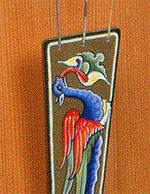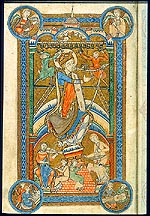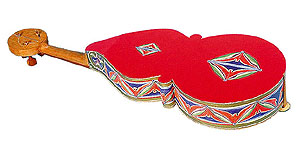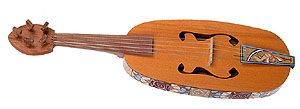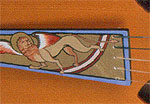
| Opus 2 - Vithele (medieval viol) |
|
|
The vithele was held on the shoulder in much the same way as a violin, although a number of paintings show musicians seated with the instrument on their knees. The vithele's shape, number of strings and bow can vary greatly. While the instrument's origins are hard to pinpoint, the bow appears to have been used in Spain and Italy in the tenth century, based on the practice in Arab and Byzantine countries. In the eleventh century, the practice spread throughout Europe, and the medieval vithele appeared around this time. The instrument remained in use until the late fifteenth century, when it was gradually supplanted by instruments related to the viola da gamba and the violin.
The tailpiece depicts a wyvern. Christopher Allworth refers to Opus 2 as a "medieval viol" to indicate that it has a lower tessitura and that it is held on the knees.
The instrument is based on an illumination in the twelfth-century York Psalter, which shows King David playing the harp surrounded by minstrels playing various stringed instruments (University of Glasgow, Ms. U.2.3). The entire instrument is painted with tempera. The back is bright red, and the ribs and peg box are covered with colourful Roman-style leaves. A wyvern, with a deer's head, bird's wings and serpent's tail, graces the tailpiece. Allworth reproduced these decorations from a thirteenth-century English manuscript in the British Museum.
Opus 3 is the smaller vithele. To build this tempera-painted replica, the luthier turned to an illumination in the thirteenth-century Bromholm Psalter and the books of the Trinity Apocalypse (Trinity College, Cambridge, Ms. R.16.2). The motifs on the tailpiece and the ribs are from two psalters preserved in the British Museum.
The tailpiece bears a winged lion whose head is surmounted by a halo, a symbol of St. Mark the Evangelist as he appears in the Westminster Abbey Psalter (circa 1340); and the blue and gold motifs on the ribs of the instrument are inspired by the Luttrell Psalter. |
||||||||||||||||||||||||||||||||||||||||||||||||||||||||||||||||||||||
 |



